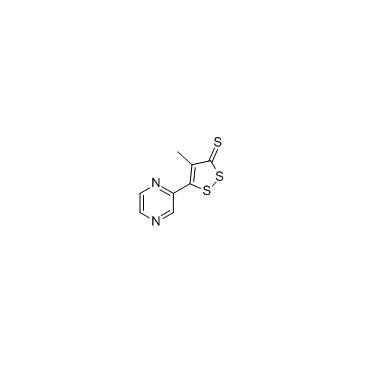Cancer chemoprotection by oltipraz: experimental and clinical considerations.
K J Helzlsouer, T W Kensler
Index: Prev. Med. 22(5) , 783-95, (1993)
Full Text: HTML
Abstract
Oltipraz (4-methyl-5-(2-pyrazinyl)-1,2-dithiole-3-thione) is an antischistosomal drug presently under evaluation as a possible chemoprotective agent in humans. To date, oltipraz has proved effective as an inhibitor of carcinogenesis in experimental models for breast, bladder, liver, forestomach, colon, tracheal, lung, and skin cancer. Studies on the mechanisms of action of oltipraz indicate that it affects the metabolism and disposition of chemical carcinogens, principally through the induction of electrophile detoxication enzymes. While this feature is common to many different classes of both natural and synthetic experimental chemoprotectors (i.e., phenolic antioxidants, isothiocyanates, flavonoids, indoles, cinnamates, coumarins, terpenes, and others), oltipraz may offer the earliest and easiest prospect for examining the role of enzyme induction as a protective strategy in humans. Unlike the situation with many of the anutrients, substantial preclinical research has already been conducted with oltipraz to establish its safety and efficacy in animals. Hopefully, Phase I investigations will demonstrate a high tolerance for oltipraz in the chemoprotective dose range of the drug. A major concern for the success of any trial is selecting participants who are likely to adhere to the intervention as well as to all aspects of the protocol. Factors influencing participation and adherence in a trial include the design of the trial, the nature of the disease under study as well as the nature of the intervention, in particular the toxicities of the intervention (J. A. Tangrea, M. E. Adrianza, and W. E. Helsel, Cancer Epi Biomarkers Prev 1992; 1:325-330). Chemoprotection trials with oltipraz have an excellent prospect for success. Individuals with known carcinogenic exposures are likely to be interested in participation in trials designed to reduce the risks of the exposures. Moreover, the availability of intermediate markers reflecting the modulation of the biologically effective dose of environmental carcinogens as study end points will enable efficient trials to be designed.
Related Compounds
| Structure | Name/CAS No. | Molecular Formula | Articles |
|---|---|---|---|
 |
Oltipraz
CAS:64224-21-1 |
C8H6N2S3 |
|
Catalase overexpression prevents nuclear factor erythroid 2-...
2014-10-01 [Diabetes 63(10) , 3483-96, (2014)] |
|
Antioxidant and mitochondrial protective effects of oxidized...
2010-02-01 [Expert Opin. Drug Metab. Toxicol. 6(2) , 213-24, (2010)] |
|
Inhibition of colon carcinogenesis by post-initiation induct...
2009-06-01 [Oncol. Rep. 21(6) , 1559-65, (2009)] |
|
Oltipraz promotion of liver regeneration after partial hepat...
2009-04-01 [Arch. Pharm. Res. 32(4) , 625-35, (2009)] |
|
Pharmacokinetic interaction between oltipraz and silymarin i...
2009-01-01 [J. Pharm. Pharm. Sci. 12(1) , 1-16, (2009)] |